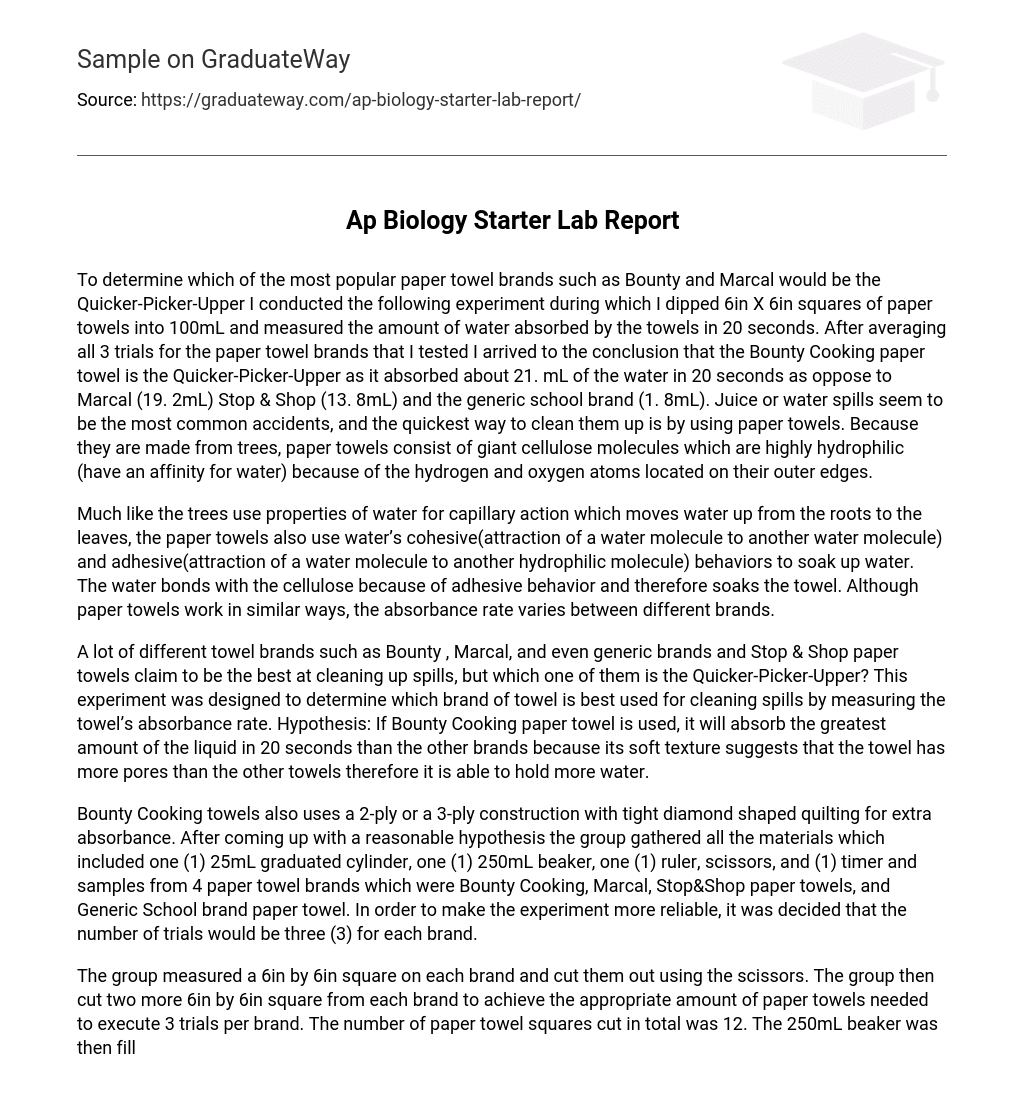To determine which paper towel brands, such as Bounty and Marcal, are the Quicker-Picker-Upper, I conducted an experiment. I dipped 6in X 6in squares of paper towels into 100mL of water and measured the amount absorbed in 20 seconds. After averaging the results of three trials for each brand, I concluded that Bounty Cooking paper towels absorbed about 21mL of water in 20 seconds. In comparison, Marcal absorbed 19.2mL, Stop & Shop absorbed 13.8mL, and the generic school brand absorbed only 1.8mL. Paper towels are commonly used to quickly clean up spills, such as those caused by juice or water. These towels are made from trees and consist of large cellulose molecules with hydrogen and oxygen atoms on their outer edges, making them highly hydrophilic (water-attracting).
Trees and paper towels both utilize water’s capillary action, cohesive behavior, and adhesive behavior. Capillary action enables water to move up from the roots to the leaves in trees. Likewise, paper towels use water’s cohesive and adhesive behaviors to absorb water. The cellulose in the paper towel bonds with the water due to its adhesive behavior, resulting in water absorption. However, the absorbance rate may differ among various paper towel brands.
A variety of towel brands, including Bounty, Marcal, and generic brands like Stop & Shop, all claim to be highly effective at cleaning up spills. However, the question remains: which one is truly the most efficient? To answer this query, an experiment was conducted to measure the absorbance rate of different towel brands when used to clean spills. The hypothesis suggests that Bounty Cooking paper towel, with its soft texture and presumably higher number of pores, will exhibit the greatest liquid absorption within a 20-second timeframe.
Bounty Cooking towels are designed with either a 2-ply or a 3-ply construction, featuring a tight diamond-shaped quilting to enhance their absorbency. To conduct the experiment, the group gathered necessary materials, including a 25mL graduated cylinder, a 250mL beaker, a ruler, scissors, a timer, and samples from four different paper towel brands: Bounty Cooking, Marcal, Stop&Shop paper towels, and Generic School brand paper towel. To ensure the reliability of the results, it was decided that each brand would undergo three trials.
The group measured and cut out a 6in by 6in square from each brand of paper towels using scissors. They then cut two more squares of the same size from each brand to have enough for 3 trials. In total, they cut 12 squares. They filled a 250mL beaker with 100mL of water. The square of School paper towel was dipped into the beaker and left there for 20 seconds. After the timer reached 20 seconds, the School paper towel was taken out of the beaker and squeezed in a graduated cylinder to measure the amount of water it absorbed.
The group first measured the amount of liquid the towel had absorbed using a graduated cylinder. Additionally, they subtracted the amount of water remaining in the beaker (originally 100mL) to obtain a more accurate measurement. The measurement was then recorded in the data table. Afterwards, the beaker was refilled to its original 100mL capacity. The group repeated these steps for the remaining towel squares, recording the data accordingly. Lastly, they utilized the remaining paper towels for cleaning purposes.
The data collected in this experiment supports the initial hypothesis that Bounty Cooking paper towel would absorb the greatest amount of liquid in 20 seconds due to its structure and texture, which enables it to absorb and retain more water than other towels. In comparison to other brands such as Marsal (19.2mL), Stop&Shop Brand (13.8mL), and Generic School Brand (1.8mL), Bounty absorbed the highest amount of water at 21.80mL. Therefore, Bounty Cooking paper towel is considered the Quicker-Picker-Upper and should be the preferred choice for quickly cleaning liquid spills.
Despite supporting the hypothesis enough to reach a similar conclusion, this experiment had certain sources of error that could have impacted the measurements and ultimately rendered the results invalid. Some of these errors included:
- The beaker used is not an instrument that has a reliable precision therefore the amount of the liquid that should have had remained constant at 100mL throughout the experiment, might have been different for every trial.
- The time the paper towels were left soaking in the water might have varied from 20 seconds to 22 because of the reaction time of both of the members of the group was NOT faster than a fraction of a second. This means that the amount of time the towels should have been left soaking did not remain constant throughout the experiment.
- Water was spilled when moving the paper towel from the beaker to the graduated cylinder and while trying to squeeze out the liquid from the towels. This could lead to inaccurate measurements, and therefore harm the reliability of this experiment.
This experiment would be enhanced by incorporating the following:
- The use of a more precise instrument such as the burette would have given more accurate data therefore making the experiment more reliable.
- If the timer was to be stopped between 19-19. 50 seconds, there would be a higher chance of keeping the time constant throughout the experiment.
- The use of a funnel would have prevented spilling of the water therefore making the data collected more valid.
- More trials should be executed in order to get a more accurate average of the measurements.





